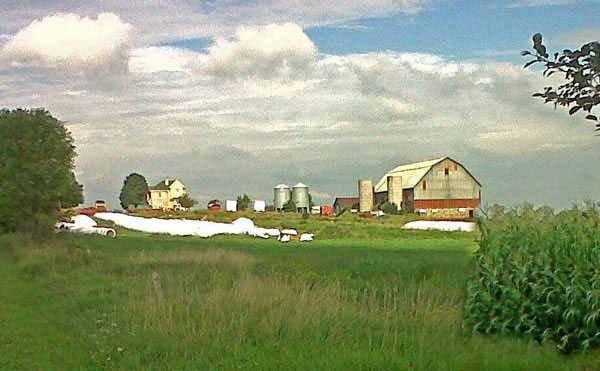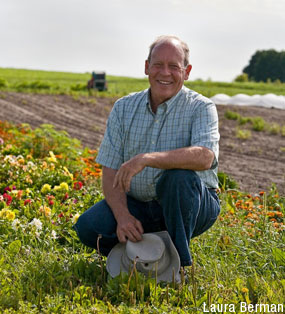Newsletters

Planning for Agriculture in the Rouge
In late February I received a call from Parks Canada to advise me that the land transfers from Provincial to Federal ownership were nearly complete. The lengthy delay was resolved by an agreement to follow Ontario ecological standards rather than the more relaxed Federal standards. Progress on creating an Agriculture and Food Hub on the agricultural lands within the new Rouge National Urban Park will soon resume.
For a better understanding of the immensity and potential of the project, please take a look at The Pickering Lands. This first-class 7-minute video is a “must-see”. A great example of the type of projects these lands could host is shown in the award winning Feeding McGill project. This 3-minute video shows how Montreal university lands are being used to transform the university's food services.

A Better Way to Feed the World’s Poor
It was in 2004 at the first Slow Food Terra Madre Conference in Turin, Italy that I first met Allan Savory. We stayed in the same Inn, so we sometimes sat together on the bus ride into the city. He told me how he formulated the link between “modern” grazing practices and the destruction of the incredibly productive soil and plentiful water in Rhodesia (now Zimbabwe). The problem was not too many grazers; it was not enough predators. This understanding led to the practice of intensive rotational grazing by substituting electric fencing for feline and canine predators to keep the grazing animals in tight groups.
My roommate at Terra Madre was a Texas cowboy who volunteered to help Mr. Savory teach the poor in dry regions around the world how to more efficiently manage their grazing animals. It formerly took a hundred people half a day to move their cattle from one field to another. After a few days of training, four people could do the same job in less than an hour. Then it would become practical to move their animals every day from one small pasture to another. Soon the fields would become green again, streams continued to flow during the dry season, trees grew, birds returned, and the people once again had plenty to eat and time to rebuild their culture and enjoy peace. This has been replicated throughout Africa, Russia, China, Mid-East, Mexico, and the U.S. But there are still a lot of customs to change.
It was a total joy to view this amazing TED video with Allan Savory. When I first saw this in early March there had been just over a thousand views; please note how many hundreds of thousands have seen it when you view this 22-minute presentation.
What we can do from Canada
The new Pope is asking that all of us consider helping the world’s poor. Shipping our cheap GMO foods only helps in the short-term; then it makes their lives worse in the long-term. Teaching the poor how to naturally take care of themselves can last forever. We don’t need to leave our homes to do this. In my consulting work with farmers, I am continually amazed with all their creative, labour-saving solutions. Some of these local developments will surely qualify for The Bill Gates Foundation grants for innovative, holistic solutions to boost labor productivity of smallholder farmers around the world.
Cover-Crop your Fields
Keeping fields covered in temperate climates is also important. Annual cropping typically leaves the soil harmfully bare for extended periods. Fast-growing cover crops are a great way to keep your valuable soil protected throughout the year. They also add benefits such as boosting organic matter, suppressing weeds, and maintaining biological activity. See this USDA article about the positive results observed in recent cover crop research.
There are often concerns about cover crops tying up nitrogen as the trash breaks down in the soil. I consider this to be an advantage. Moderate nitrogen and water stresses boost flavour (and presumably nutrition) as well as reduce pest pressure. Yes, this may reduce yields. But then you can find ways to market superior tasting food to eager customers who are very willing to pay higher prices for richer flavours.
Participate in your own Backyard
Mark Cullen, the garden expert, and I were speakers at an Ecological Gardening Conference. He related the story of a gardener who had passed on.
God happened to be at the pearly gates at the same time as the gardener. So God asked the gardener how lawn grass was working out. God proudly went on to say that he considered this to be his very best invention – it kept the soil covered, this crowded out weeds, it shaded the soil to keep it cool and moist, deep roots kept the grass green most of the year (temporarily turning a pleasing beige during a draught), its trimmings broke down to create its own fertilizer, insects would ignore the sturdy leaves. All it needed was to be cut ankle-high every couple weeks.
The gardener replied that this is not how it is actually working out. People prefer their lawns short. The soil overheats and requires frequent watering. The grass then grows so fast that it must be cut every few days. There are so many clippings that they need to be raked away. The unshaded soil becomes so hot that some grass dies. This provides space for weeds to grow. So we need to purchase and spread an herbicide to kill the weeds. And then we need to purchase and spread more grass-seed to fill the holes. With no clippings we then need to purchase and spread fertilizer. This then makes it lush enough for insects to eat. Then we need to purchase and spread an insecticide to kill them.
I don’t recall the punch line, or which way St. Peter directed the gardener. But when Mark returned to the table, I asked him what portion of his nursery sales came from lawn products. After he answered 60%, I asked if telling this story would cut into these sales. He replied that there is plenty of advertising to keep his customers buying all these lawn products.
| forward to a friend and suggest signing up to receive this newsletter every month. |

